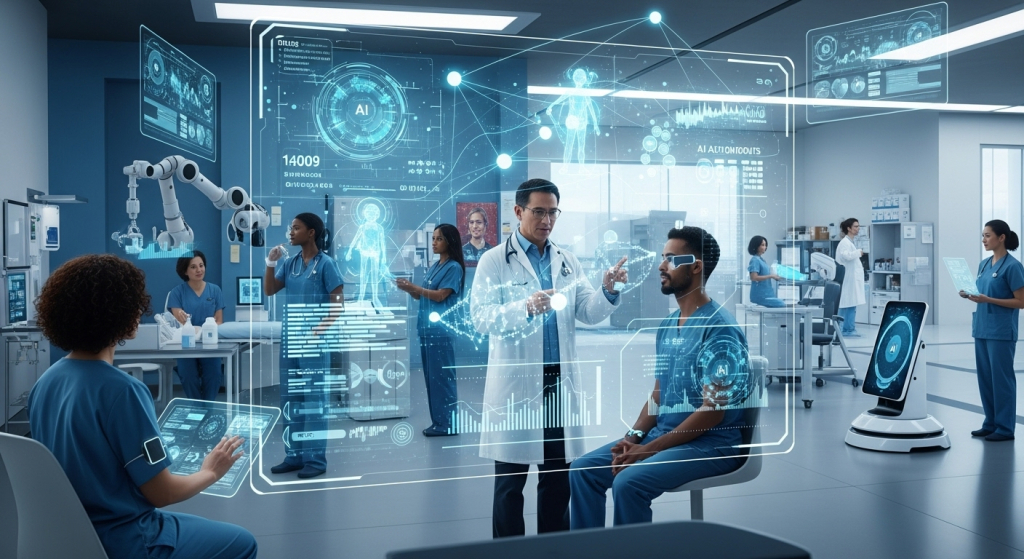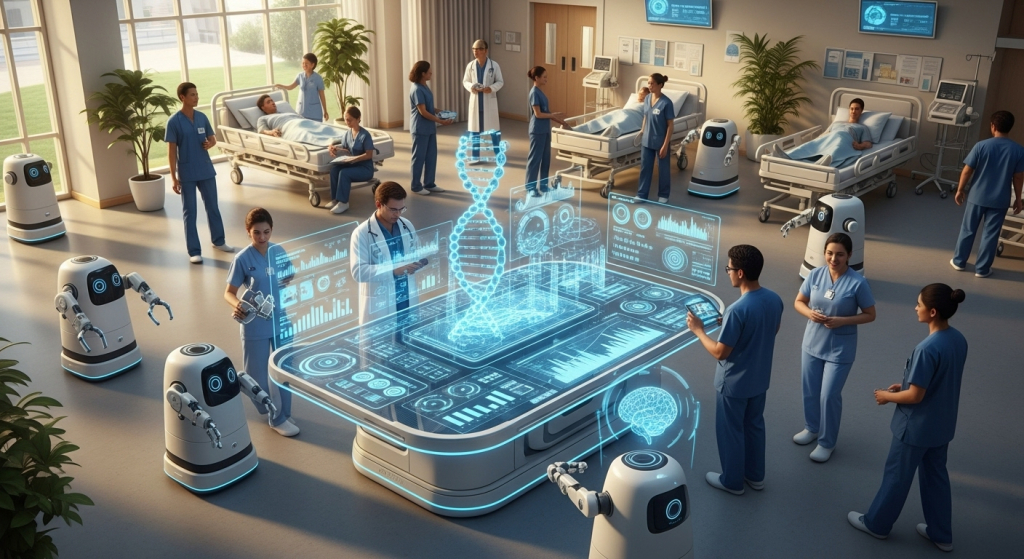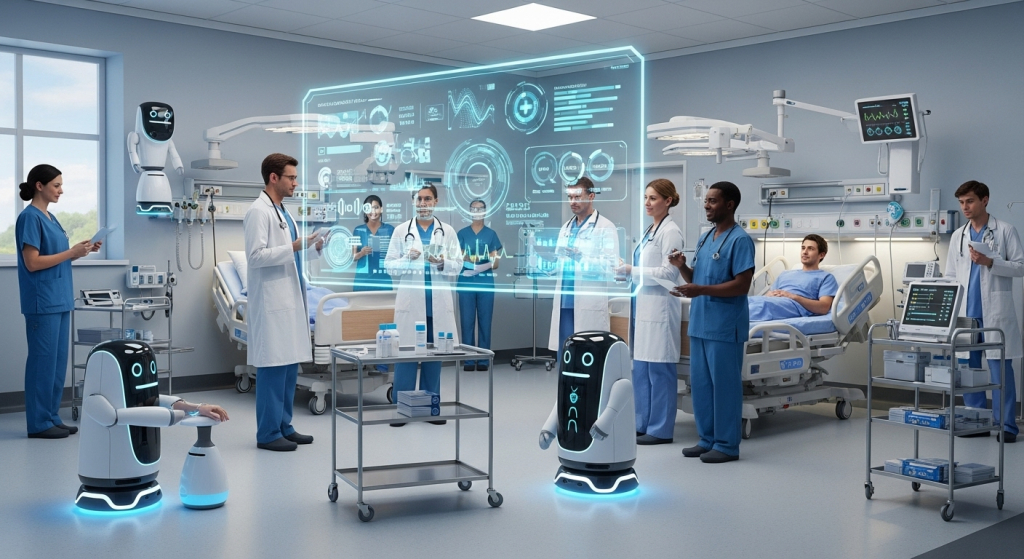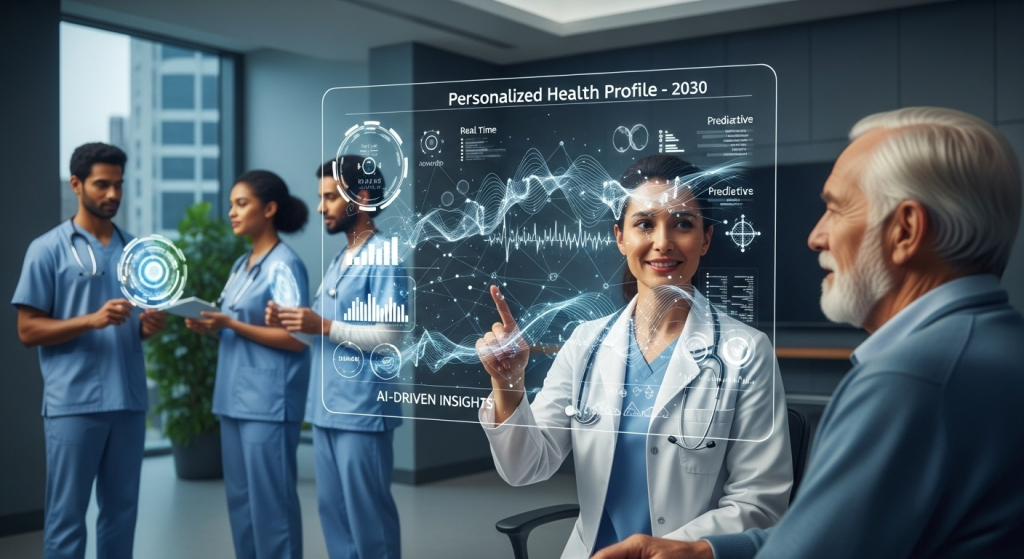Imagine a world where your healthcare system anticipates your needs before you even realize them. A world where your personal health data flows seamlessly and securely between your smartwatch, your family doctor, a specialist, and a hospital, telling a complete story of your well-being. That is the tangible promise of health in 2030, driven by a revolutionary concept called the Intelligent Health System.

For decades, we’ve navigated a fundamentally reactive system. We wait for symptoms to appear, schedule an appointment, and then begin the often-fragmented journey of diagnosis and treatment. Records are faxed. Patients repeat their medical history to every new provider. Critical data remains locked away in incompatible digital silos. This model is inefficient, costly, and ill-equipped to handle the complexities of chronic disease and an aging global population.
The future of health in 2030 hinges on a radical paradigm shift. We are transitioning from a system of sick care to one of genuine healthcare – proactive, predictive, personalised, and participatory. At the heart of this transformation lie two key pillars: radically interoperable data and intelligent autonomous agents. Together, they form an ecosystem that not only treats illness but also actively cultivates wellness. This article explores this emerging reality, breaking down the components, the global health vision, and the great impact of the Intelligent Health System.
Ready to transform your healthcare operations? We specialize in developing and integrating custom AI solutions that turn complex data into predictive insights!
The Cracks in the Foundation: Why Today’s Healthcare Model is Unsustainable
To understand where we are going, we must first be honest about where we are. The modern healthcare system, for all its miraculous advancements, is cracking under immense pressure. Physician burnout is at an all-time high, driven by overwhelming administrative burdens and inefficient workflows. Healthcare costs continue to spiral upwards, consuming an ever-larger portion of national budgets without a proportional increase in positive health outcomes.
The core of the problem is data fragmentation. A single patient’s health record can be scattered across dozens of incompatible electronic medical record (EMR) systems, pharmacy databases, wearable device apps, and insurance portals. That creates a disjointed and incomplete picture of a person’s health, leading to:
- Diagnostic Delays and Errors. Clinicians are forced to make critical decisions with partial information.
- Redundant Testing. A test performed at one facility is often repeated at another because the results are not accessible.
- Poor Care Coordination. Specialists, primary care physicians, and therapists often struggle to collaborate effectively, leaving patients to act as the primary (and often overwhelmed) messengers.
- Stifled Innovation. Researchers often struggle to access large, anonymized datasets to identify trends, test hypotheses, and develop new treatments.
This fractured landscape is precisely what the vision for health in 2030 aims to dismantle. The goal is to build a new foundation, one where data flows seamlessly, empowering every stakeholder in the healthcare ecosystem.
Defining the New Paradigm: What is Vision 2030 in Healthcare?
When we ask, “What is vision 2030” in the context of health, we are talking about a globally recognized ambition to build more intelligent, more resilient, and more equitable health systems. While specific national strategies differ, they share a common DNA. This vision is about a re-architecting of the entire health ecosystem around the patient.
The core tenets of this vision include:
- From Reactive to Predictive & Proactive. Shifting the focus from treating sickness to preventing it. That involves using continuous data streams from wearables, environmental sensors, and genomics to identify risks long before symptoms manifest.
- From One-Size-Fits-All to Personalized. Tailoring treatments, medications, and wellness plans to an individual’s unique genetic makeup, lifestyle, and environment.
- From Episodic to Continuous. Moving away from sporadic clinic visits to a model of constant, ambient health monitoring and engagement, managed by intelligent tools.
- From Siloed to Integrated. Creating a unified health data infrastructure where information is accessible, secure, and available at the point of care, research, and policy-making.
| Aspect | Today’s Healthcare (Reactive Model) | Health in 2030 (Intelligent System) |
|---|---|---|
| Care Model | Reactive (responds to symptoms) | Proactive & Predictive (prevents illness) |
| Data Structure | Siloed, fragmented, inaccessible | Interoperable, fluid, patient-centric |
| Patient Role | Passive recipient of care | Empowered, active participant |
| Health Monitoring | Episodic (clinic visits, annual checkups) | Continuous (wearables, home sensors) |
| Clinician Focus | Diagnosis, treatment, administrative tasks | Complex cases, empathy, health coaching |
| Decision Making | Human-led, based on available data | AI-augmented, based on comprehensive data |
Countries around the world are formalizing this ambition. A prime example is Vision Canada, which is actively pursuing a Pan-Canadian Health Data Strategy. The strategy focuses on creating a seamless data ecosystem to enhance care for Canadians, empower patients with their own information, and drive world-class health research. It’s an explicit acknowledgement that a nation’s health is inextricably linked to its data infrastructure. This move by Canada exemplifies the global understanding that the future of medicine is closely tied to the future of data. The pursuit of better health in 2030 is, therefore, a pursuit of data liberation.
The Bedrock of Tomorrow: Radically Interoperable Data
Interoperability is the ability of various information systems, devices, and applications to access, exchange, integrate, and cooperatively use data in a coordinated manner. In healthcare, it means a patient’s MRI scan from a hospital can be instantly viewed by their primary care physician on a different EMR system. Besides, its findings can be integrated into the AI-powered app on the patient’s phone. For years, this has been the holy grail of health IT. Now, thanks to universal standards, it’s becoming a reality.
The Technology Making It Possible
A suite of powerful techs is driving this move from a theoretical ideal to a functional reality.

- FHIR (Fast Healthcare Interoperability Resources). Pronounced “fire,” FHIR is the game-changing standard for exchanging healthcare information electronically. Unlike older, more rigid standards, FHIR is built on modern web technologies (like the APIs used by your smartphone apps). It treats health data — like a patient’s name, a lab result, or a medication — as a discrete “resource” that can be easily requested and shared. That enables faster, simpler, and more flexible data exchange.
- Application Programming Interfaces (APIs). APIs are the messengers that allow different software applications to talk to each other. In an FHIR-based system, a hospital’s EMR can have an API that allows a verified third-party app (like a patient’s personal health dashboard) to request specific data with the patient’s consent.
- Blockchain Technology. While not a replacement for EMRs, blockchain offers an unprecedented layer of security and trust for health data. It can be used to create an immutable, decentralized ledger of who has accessed a patient’s data and when, giving patients actual ownership and control over their information. It ensures the integrity and provenance of data, which is critical for health in 2030.
Combined, these innovations create a secure, agile, and fluid data infrastructure that was previously unimaginable in healthcare.
The Impact of Liberated Data
When data flows freely and securely, the entire system is transformed.
- The Seamless Patient Journey. A patient can move between providers, cities, or even countries, and their complete, up-to-date health record travels with them. No more filling out repetitive forms. No more “falling through the cracks.”
- Powerful Population Health. Public health officials can analyze real-time, anonymized data to identify disease outbreaks instantly, spot community health trends, and allocate resources more effectively.
- Accelerated Medical Research. Researchers can gain secure, consent-driven access to vast datasets, dramatically speeding up clinical trials and the discovery of new treatments and cures.
This free flow of data elevates the standard of care for individual patients, entire populations, and future generations alike.
The Workhorses of the System: Autonomous Agents and AI
If interoperable data is the bedrock, then autonomous agents are the intelligent workhorses building the future of health upon it. This agent is a sophisticated AI system that can perceive its environment and act independently to achieve specific goals. They are the “doers” in the Intelligent Health System, constantly analyzing data and taking action. Such agents will operate across three critical tiers, each contributing to a more efficient vision of health in 2030.
| Agent Tier | Primary User | Key Functions |
|---|---|---|
| Patient-Facing | The Individual / Patient | Proactive monitoring, chronic disease management, system navigation, scheduling. |
| Clinician-Supportive | Doctors, Nurses, Specialists | Diagnostic assistance, administrative automation, evidence synthesis. |
| System-Level | Hospital Admin, Public Health | Resource management, supply chain optimization, population health surveillance. |
1. Patient-Facing Personal Health Agents
That is where healthcare becomes truly personal. Every individual will have a secure, AI-powered “health guardian” on their smartphone or personal device. Fed by a continuous stream of data from wearables (heart rate, sleep, glucose levels), home sensors (air quality, activity), and their official EMR, this agent will:
- Proactively Monitor and Alert. Detect subtle deviations from a person’s health baseline and alert them to potential issues (e.g., “Your blood pressure has been trending high for three days. I’ve scheduled a telehealth check-in for you.”).
- Manage Chronic Conditions. Provide real-time coaching for individuals with diabetes, remind patients to take their medications, and track the effectiveness of treatment plans, alerting clinicians only when human intervention is necessary.
- Navigate the Healthcare System. Find in-network specialists, schedule appointments that fit the user’s calendar, prepare pre-visit summaries for the doctor, and handle insurance queries.
In essence, these agents transform the patient from a passive recipient of care into an empowered director of their own wellness journey.
2. Clinician-Supportive Agents
These agents are designed to eliminate administrative drudgery and augment the decision-making capabilities of human clinicians, freeing them to focus on what they do best: complex problem-solving and providing empathetic care.
- Diagnostic Assistants. Analyze medical images (X-rays, CT scans) and pathology slides, flagging areas of concern for the radiologist or pathologist with a high degree of accuracy. They won’t replace the expert but will act as an infallible second set of eyes.
- Clinical Workflow Automators. Listen in (with consent) on a patient-doctor conversation, automatically transcribe notes, populate the EMR, queue up prescriptions, and generate referral letters, saving doctors hours of paperwork each day.
- Evidence Synthesizers. When faced with a rare or complex case, a clinician can ask the agent to instantly review millions of research papers, clinical trials, and case studies to provide a summary of the latest evidence-based treatment options.
Ultimately, these agents reduce clinician burnout and amplify their expertise, allowing them to practice at the very top of their license.
3. System-Level Administrative Agents
Operating at the hospital or health system level, these agents are the unseen optimizers that ensure the entire operation runs smoothly.
- Resource and Bed Management. Analyze real-time admissions, discharges, and surgical schedules to predict demand and optimize patient flow, reducing wait times and ensuring beds are available.
- Supply Chain Optimization. Monitor the usage of medical supplies, from surgical gloves to expensive pharmaceuticals, and automatically reorder inventory to prevent shortages and reduce waste.
- Public Health Surveillance. Anonymously aggregate data from across a region to provide public health authorities with an up-to-the-minute view of infectious disease trends, enabling rapid response.
In short, these system-level agents form the invisible backbone of a resilient, efficient, and data-responsive health organization.
A Day in the Life: Experiencing Health in 2030
To make these concepts concrete, let’s follow Anya, a 45-year-old architect, through a future health experience.

7:00 AM: Anya’s smartwatch vibrates. A notification from her Personal Health Agent, “Aura,” appears: “Good morning, Anya. I’ve detected a pattern of atrial fibrillation in your sleep data over the past week. While your risk is low, I’ve cross-referenced this with your genomic data, which shows a slight predisposition. To be proactive, I’ve scheduled a 15-minute virtual consultation with your cardiologist’s office for 11:00 AM today and pre-ordered a 7-day ECG patch to your home.”
Anya accepts the appointment with a tap. Aura has already checked her work calendar and the cardiologist’s availability.
10:50 AM: Aura sends a reminder and a secure link for the virtual visit. It has also compiled a concise summary for the clinician, including the relevant heart rate data, Anya’s EMR summary, and family history.
11:00 AM: The cardiologist, Dr. Evans, joins the call. He doesn’t need to ask Anya for her history; it’s all on his screen, organized by his own Clinician-Supportive Agent. “Good morning, Anya. I see Aura flagged some irregular rhythms. Let’s talk about what you’ve been feeling.” His agent listens in, transcribing the conversation and highlighting key symptoms.
11:15 AM: Dr. Evans confirms the plan. “The ECG patch will give us a clearer picture. My agent has already authorized the prescription and linked it to your personal health record. Aura will guide you on how to use it when it arrives tomorrow.” The entire visit is coded, billed, and documented automatically before Dr. Evans even clicks “end call.”
One Week Later: The data from the ECG patch streams directly and securely to Dr. Evans’s system. His diagnostic agent analyzes the 1.2 million heartbeats recorded, confirming intermittent atrial fibrillation and flagging it for his review. He confirms the diagnosis and, with the help of an AI tool that considers Anya’s genetics and lifestyle, approves a personalized care plan involving a low-dose medication and specific dietary recommendations.
Aura receives the care plan, adds medication reminders to Anya’s calendar, suggests recipes that align with her dietary goals, and sets up a schedule to monitor her blood pressure and heart rate to track the medication’s effectiveness. So, Anya is an empowered partner in managing her own health and well-being. This seamless, proactive process is the reality of health in 2030.
Global Perspectives and Collaborative Models: Vision Canada & Level Green Partners in Health
This transformation is not happening in a vacuum. It requires significant collaboration. Again, looking at Vision Canada provides a tangible roadmap. Their strategy is about governance, creating common standards, and ensuring public trust. It recognizes that to achieve the future of health in 2030, federal and provincial governments, technology vendors, hospitals, and research institutions must work in concert.
That leads to a crucial concept we can call “Level Green Partners in Health.” It represents the ideal state of collaboration required to run an Intelligent Health System. “Level Green” signifies a system operating at peak efficiency, safety, and sustainability. Achieving this state depends on a multi-stakeholder partnership:
- Governments & Regulators. Must create clear, agile regulatory frameworks for data privacy (like GDPR and its successors), AI ethics, and data sharing. They set the rules of the road to ensure safety and build public trust.
- Technology Companies. Responsible for building secure, interoperable platforms based on open standards, such as FHIR. They must work in partnership with healthcare organizations, not just as vendors, to achieve this goal.
- Healthcare Organizations. Need to champion this change internally, investing in modern infrastructure and, crucially, in retraining their workforce to collaborate with AI and leverage data-driven insights.
- Patients and Advocacy Groups. Must be at the center of the design process. They are the ultimate end-users, and their trust, engagement, and feedback are essential for the system to succeed.
This concept of Level Green Partners in Health moves beyond simple public and private efforts. It’s an ecosystem mindset where every participant shares responsibility for the collective health outcome. The goal is a system where data flows and actions are taken in a way that is ethical, equitable, and effective for everyone. It directly addresses the core challenge raised by the question, “What is vision 2030?” — it’s about how we as a society agree to implement the tech.
Navigating the Hurdles: The Challenges on the Road to 2030
The path to the Intelligent Health System is not without significant obstacles. Building this future requires confronting serious ethical, technical, and social challenges head-on.

Data Privacy and Cybersecurity
An interconnected health system is a rich target for cyberattacks. Protecting sensitive personal health data in a highly interoperable environment is paramount. Robust encryption, multi-factor authentication, and blockchain-based consent management will be essential. Patients must have absolute transparency and control over who can access their data and for what purpose.
Ethical AI and Algorithmic Bias
AI models are trained on data. Suppose that data reflects existing historical biases in healthcare (e.g., certain conditions being under-diagnosed in women or minority population groups). In that case, the AI will learn and perpetuate those biases, potentially worsening health disparities. Ensuring fairness, transparency, and “explainability” in AI algorithms is one of the most critical ethical challenges we face. Rigorous testing and diverse datasets are non-negotiable.
Regulatory and Legislative Lag
Technology is evolving far faster than the law. Governments and international bodies must work quickly to establish clear guidelines for using autonomous agents in clinical decision-making. Who is liable if an AI agent contributes to a diagnostic error — the developer, the hospital, or the clinician who used it? These questions need answers to ensure accountability.
The Human Element: Workforce Training and Patient Trust
The role of the healthcare professional is evolving. We need to retrain doctors, nurses, and technicians to become “data interpreters” and expert users of AI-augmented tools. Their focus will shift from routine tasks to complex, human-centered care. Simultaneously, we must earn the trust of our patients. People of all ages will only embrace this new model if they feel their data is secure, the AI is fair, and the human connection in healthcare is being enhanced, not replaced.
Conclusion: A New Covenant for Health
The journey toward health in 2030 is the forging of a new covenant for health and wellness. The Intelligent Health System, powered by the synergy of interoperable data and autonomous agents, represents a fundamental shift from a fragmented, reactive industry to a cohesive, proactive ecosystem dedicated to healthy people.
We are moving beyond the episodic encounters that have defined healthcare for a century. In their place will be a continuous, data-informed conversation between individuals and their health guardians — both human and digital. The challenges of privacy, ethics, and regulation are immense, but they are not insurmountable. Through thoughtful design and a collaborative spirit embodied by models like Vision Canada and the concept of Level Green Partners in Health, we can build a future where tech amplifies human expertise, where data serves humanity, and where every individual is empowered to live their healthiest possible life.
Want to free your staff from administrative burdens? We build HIPAA-compliant voice AI solutions that streamline clinical data and patient engagement. Just imagine hands-free note-taking and real-time conversations!
FAQ
What is an ‘Intelligent Health System’ in simple terms?
An Intelligent Health System is a future healthcare model that shifts the focus from reacting to sickness to proactively maintaining wellness. Instead of waiting for you to get sick, it uses continuously connected data from sources like wearables and your medical records, along with AI, to predict health risks. That allows for personalized, preventive care that anticipates your needs, making healthcare a constant support system.
Will an AI agent replace my doctor by 2030?
No, the goal is to augment doctors, not replace them. In the healthy people 2030 vision, AI agents act as powerful assistants. They handle time-consuming administrative tasks, analyze complex data, and provide diagnostic support, freeing clinicians to focus on what they do best: complex problem-solving, patient relationships, and empathetic care. Your doctor’s expertise is enhanced by AI, enabling them to provide even better, more targeted treatment and advice.
How does ‘interoperable data’ actually help me during a hospital visit?
Interoperable data means your medical history is securely available to any authorized provider instantly. If you visit an emergency room, the doctor can review your allergies, medications, and recent lab results from your family physician without needing you to recall every detail. That prevents dangerous drug interactions, avoids redundant and costly tests, and leads to a faster, more accurate diagnosis, creating a seamless and safer patient journey for you.
With all my health data connected, how is my privacy protected?
Protecting your privacy is a cornerstone of the future health system. Security relies on multiple layers, including advanced encryption and modern technologies like blockchain, which can create an unchangeable record of who accesses your data and when. Crucially, this system is built on a foundation of patient consent, giving you direct control over your information. That ensures that while your data is available to improve the health and well-being, it remains fundamentally yours and is protected by strict regulations.
What exactly is a ‘Personal Health Agent’?
A Personal Health Agent is like a 24/7 health guardian living on your smartphone. This AI tool will be connected to your health data, monitoring aspects such as your heart rate, sleep patterns, and glucose levels from your wearable devices. It can proactively alert you to potential issues, help you manage a chronic condition with personalized advice, remind you to take medication, and even navigate the healthcare system by scheduling appointments.
Why are concepts like ‘Vision Canada’ important for this future?
Initiatives like Vision Canada are crucial because they represent the national-level planning required to make the Intelligent Health System a reality. A single hospital or tech company can’t build this future alone. These government-led strategies establish common standards, data-sharing agreements, and regulatory frameworks that enable all components of the healthcare ecosystem to connect and collaborate securely and effectively.
What is the biggest challenge to achieving this vision by 2030?
Beyond the technology itself, the biggest hurdles are human and ethical in nature. We must address algorithmic bias to ensure AI provides fair outcomes for everyone, regardless of background. Lawmakers must establish new regulations for AI-driven medicine to ensure accountability and safety. Furthermore, we must invest heavily in retraining the medical workforce and earning public trust, ensuring that patients feel secure and that the human connection in healthcare is strengthened, not lost.



